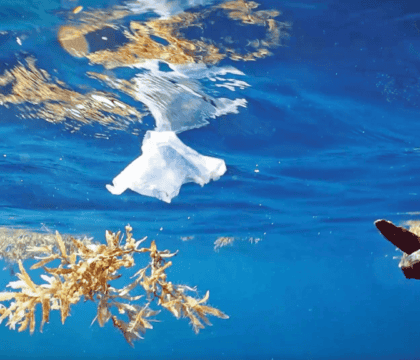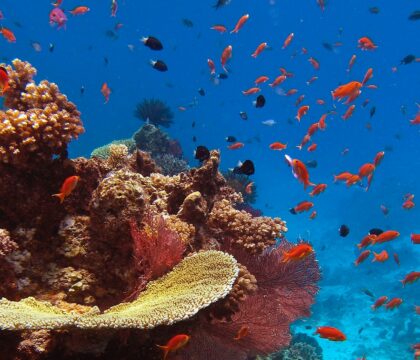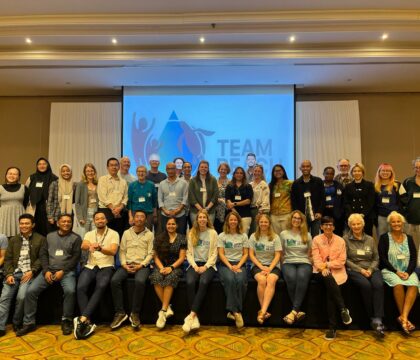July 3, 2018 • Trip Reports
I have lived in Ecuador, South America for 32 years and have travelled the continent extensively. One destination that retains an inexplicable calling is Guyana.
Having published arguably the two most important coffee-table books on the country, I have been privileged to have traveled its length and breadth by road, boat, and helicopter. The continent’s only English-speaking country, Guyana is virtually pristine and rich in biodiversity including a ‘full house’ of the South American giants. An undiscovered jewel, it is, with good reason, a firm favorite in our suite of expeditions.
Pete Oxford Expeditions is proud to jointly lead many trips with Oceanic Society. Our 2018 expedition to Guyana was no exception, and after assembling the group at Georgetown’s colonial Cara Lodge we headed out the following morning in our privately charted Cessna Caravan aircraft to land at Guyana’s most iconic destination—Kaieteur Falls. This stunning waterfall, set in the wilds of a pristine forest is the world’s highest single-drop waterfall, several times higher than Niagara at 741 feet. With a choice of spectacular lookout points and no barriers whatsoever, the experience transports the visitor back to an ageless time when Nature was still in charge. As if that was not enough, in the falls we absorbed ourselves in finding the endemic golden frogs at the base of the leaves of the humongous and omnipresent giant bromeliads.
Spectacular Kaieteur Falls. © Pete Oxford
Before returning to the aircraft we ducked into the forest to the well-known lek of one of the country’s most flamboyant birds. We easily spotted the gaudy, bright orange male Guianan Cock-of-the-Rock on his favorite perch. Obligingly, he let each of us photograph him in his element offering various poses as we did so.
The Guianan Cock-of-the-Rock. © Pete Oxford
Taking off from the dirt strip at the falls, the pilot offered both port and starboard sides an intimate aerial view of the Potaro River thundering over the escarpment as we turned north to Fairview and the Iwokrama forest. Checking in to the Iwokrama Lodge on the bank of the mighty Essequibo River our first call was to Sankar, a huge black caiman that has been hanging around the dock for many years. Portrait photography of this living dinosaur was spectacular, as his prehistoric gaze stared down the barrel of the lens to be immortalized in an image.
A large black caiman on the Essequibo River. © Pete Oxford
Iwokrama has been well-studied scientifically and is well known for its huge biodiversity. Many species are endemic to the Guiana Shield on which the lodge sits and are different from those found in the main Amazon rainforest. This is of particular note to birdwatchers who ‘flock’ to the area for new ticks on their list.
Using a spotlight on our evening boat ride on the river, we found many more caiman, some roosting birds, including the very attractive Capped Heron, and two tree boas hunting for food.
From Iwokrama we had elected to leave to our next destination – Atta Lodge and the canopy walkway – via open truck at night along the ‘main road’. Although the dirt track is indeed the main artery connecting the coast to the interior and the Rupununi Savannas, it travels in a virtual straight line through primary rain forest. It has become the best spot in Guyana to see jaguars. We had a good spotlight, drove slowly and had our eyes peeled. Although I’ve seen quite a few on this road before, this time we were not so lucky and the jags remained elusive.
At first light, we hiked the 500 meters from our lodge to the canopy walkway, a series of 3 platforms some 30 meters in the canopy. We spent the morning looking at the birds that came through and listened to the unmistakable, megaphonic sounds of howler monkeys.
From Atta we were preparing to drive to a spot from where we could hike into the forest to hopefully find a Harpy Eagle—the most powerful eagle in the world. Camera packs were already loaded in the vehicle when, unbelievably, an adult Harpy Eagle flew right into camp! A Harpy in the hand was definitely worth one in the bush so we stayed and marveled at the one that had come to us.
Our next stop was Rewa, an Amerindian owned and operated eco-lodge. Rewa is known for its healthy population of arapaima, another South American giant and one of the largest freshwater fish in the world. It was not always so, but once the community realized that the population of arapaima was dwindling they initiated a self-imposed moratorium on fishing these fish for 5 years until the population was seen to increase. Arapaima are territorial and obligate air-breathers, meaning that they periodically break the surface to gulp air. Individual fish can therefore be identified by size and sex to the trained eye. Hunting with bow and arrow, the fishermen can then selectively take individual fish in a sustainable manner. Their entire project has been heralded as a conservation success and numbers are once again at a high level. We spent an afternoon at one of the well-known arapaima lakes, surrounded by giant waterlilies waiting for the huge fish to break the surface, gulp, and roll.
A weeper capuchin. © Pete Oxford
Boat trips on the river from Rewa also showed us several troops of monkeys, a plethora of herons, Large-billed Terns and Black Skimmers. Night walks produced many smaller animals and birds, not least of which were a dozen or so pink-toed tarantulas!
Our last stop was to be the famed Karanambu lodge – home of the “otter lady,” the late Diane McTurk. A legend in her own lifetime, Diane had dedicated the latter part of her life to rehabilitating giant otter orphans back to the wild. Steeped in tradition and the true spirit of pioneers, Karanambu is a delight and a worthy finale. Through a combination of walks and boat rides, we could secure great views of many bird species and of course giant otters. These, the longest otter species in the world, are highly endangered throughout most of their range with Guyana being one of the last strongholds of the species. Highly social animals, they are very efficient predators and seem to be able to catch a good-sized fish any time they put their mind to it.
© Pete Oxford
Perhaps the highlight of Karanambu, however, was our early morning sojourns by 4×4 out into the Rupununi savannas. With a local vaquero (cowboy) on horseback to guide us, we always managed to get excellent views of one of the animal kingdom’s most bizarre denizens—the giant anteater—a strange animal indeed. Somewhat laterally-flattened, the shaggy beast walks awkwardly on large claws that it uses to break open hard termite mounds whereupon it squats on its haunches to lap up the teeming insects with its long sticky tongue.
A giant anteater on the Rupununi savanna. © Pete Oxford
The camaraderie of a great group, lively meal time conversations, and the wonder of new lifetime experiences—our 2018 Guyana trip lived up to expectations. I miss it already!
To learn more about Oceanic Society and Pete Oxford Expeditions’ Guyana expeditions, including dates, itinerary details, photos, and more, visit our Guyana: Pristine Rainforest, Savannah, and Wetlands trip page.




